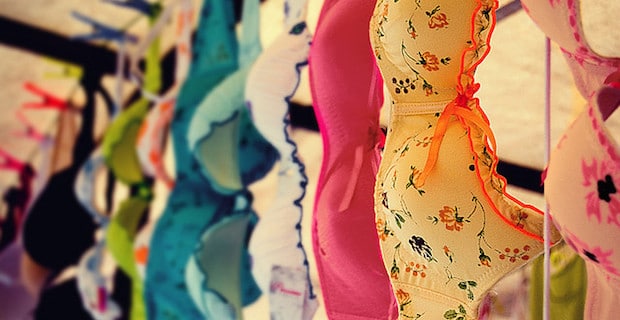
It's part of being a woman, in the Western world, at least. Who doesn't remember their first bra? While it may have at first, felt like the most ridiculous abomination to the human body, many women grow to love and even feel naked without one on.
Regardless of cup sizes, it's estimated that as much as 90 percent of the female population (in the U.S.) regularly wears a bra. Sure, they're functional and even necessary for women of a certain size; but they're even acceptable in today's fashion world-a strap shown here, a little lace, there-bras are sexy and fun, too. But could they be bad for our health?
Read more about breast health
Rumors that underwire bras posed a health risk began surfacing about a decade ago. The theory was that the tighter the bra fit, the more at-risk you were for developing breast cancer. The rigidity of the underwire was believed to limit the body's ability to drain the lymph nodes, trapping toxins in the breast tissue that eventually led to tumors. While studies have debunked this myth, practitioners of Traditional Chinese Medicine point to NeuroLymphatic Reflexes on the body that can be blocked by the placement of underwire bras, causing issues with the gal bladder and liver that share the same reflexes. Other theories suggest long-term exposure to metal that close to our bodies can be too stimulating and cause problems.
Fabrics used in bras have evolved significantly over the years, and today's bras are primarily made of materials including spandex and latex, along with satin, lace, and foam. Beyond its wonderful ability to hold us together, Spandex contains chemicals including TDI and MDI (Toluene-2,4-diisocyanate; Methylene bisphenyl-4,4-diiisocyanate), which are known toxins. TDI has been shown to have carcinogenic properties along with skin irritating effects. Latex is a known allergen that can irritate the skin and cause respiratory issues.
There has also been a notable rise in foam bras in recent years. It's actually kind of difficult these days to find a bra that doesn't contain foam. Regardless of your cup size, the perceived benefit in foam bras is that they cover up the nipple. Credit American film censors of the 1930s for establishing the nipple as obscene, even if only a slightly visible bump beneath a blouse.
Most foam bras feature polyurethane, which is made from petroleum. It's known for emitting VOCs (volatile organic compounds) that can cause respiratory issues. Polyurethane is also a landfill nightmare, as it doesn't break down.
Read more about toxic ingredients in women's products
While there's still no conclusive evidence that links bras to long-term health issues, you can reduce your risks in a number of ways:
1. Don't wear them when you don't have to. Sure it may not feel right to let it all hang out at the office, but you can at home. Wear a lightly supportive camisole or tank top if you don't feel comfortable going totally bra-free.
2. Change it up. Underwire bras are certainly an anti-gravity achievement, but they're not necessary every day. Try to have a variety of wireless options too that you can work into your bra rotation.
3. Buy organic bras. Yes, organic bras! There are quite a few brands of organic bras available (selling mostly online). Not only are they free from the questionable materials, but they're also using organic cotton, which is free of GMOs, too.
Keep in touch with Jill on Twitter @jillettinger
Photo credit: Melissa Maples
Resources:
Ask Umbra: What's that stuff in my bra?
http://www.relfe.com/underwire_bras_dangers.html




